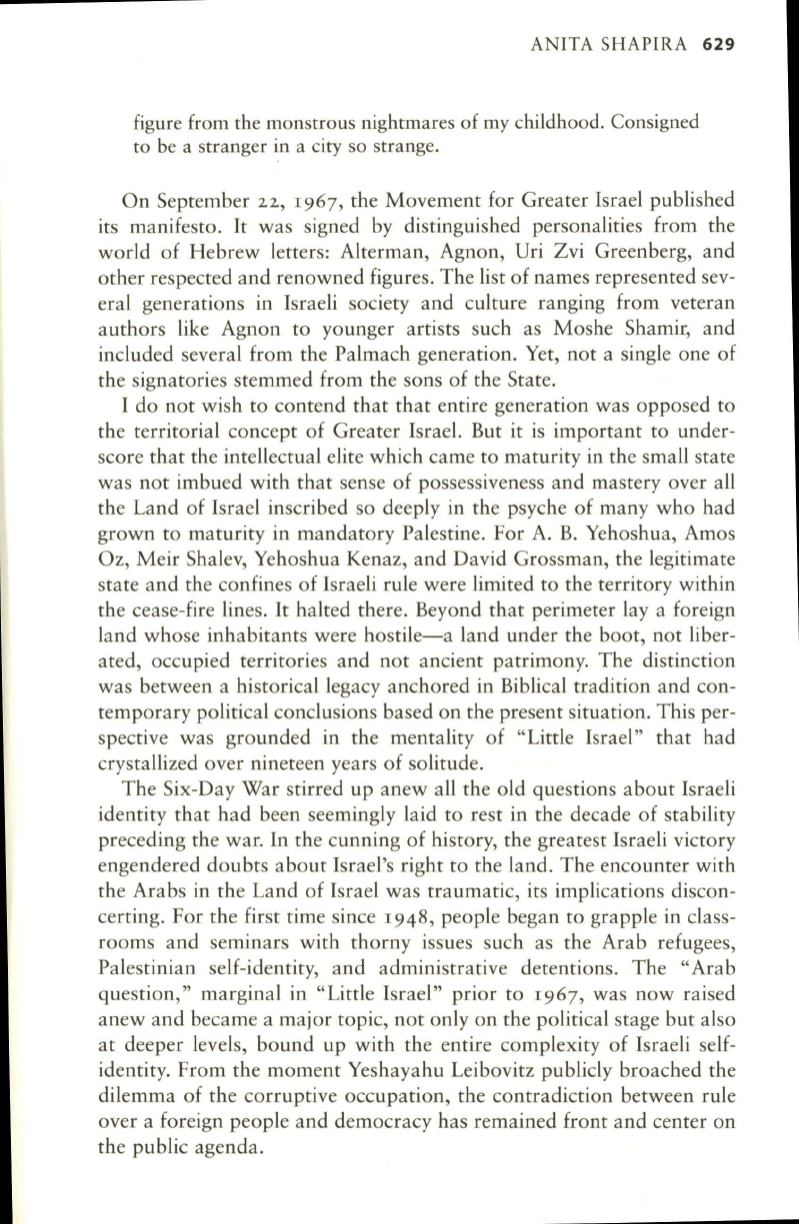
ANITA SHAPIRA
629
figure from the monstrous nightmares of my childhood. Consigned
to
be a stranger in a city so strange.
On September
22,
I967,
the Movement for Greater Israel published
its manifesto.
It
was signed by distinguished personalities from the
world of Hebrew letters: Alterman, Agnon, Uri Zvi Greenberg, and
other respected and renowned figures. The list of names represented sev–
eral generations in Israeli society and culture ranging from veteran
authors like Agnon to younger artists such as Moshe Shamir, and
included several from the Palmach generation. Yet, not a single one of
the signatories stemmed from the sons of the State.
I do not wish to contend that that entire generation was opposed to
the territorial concept of Greater Israel. But it is important to under–
score that the intellectual elite which came to maturity in the small state
was not imbued with that sense of possessiveness and mastery over all
the Land of Israel inscribed so deeply in the psyche of many who had
grown to maturity in mandatory Palestine. For A. B. Yehoshua, Amos
Oz, Meir Shalev, Yehoshua Kenaz, and David Grossman, the legitimate
state and the confines of Israeli rule were limited to the territory within
the cease-fire lines.
It
halted there. Beyond that perimeter lay a foreign
land whose inhabitants were hostile-a land under the boot, not liber–
ated, occupied territories and not ancient patrimony. The distinction
was between a historical legacy anchored in Biblical tradition and con–
temporary political conclusions based on the present situation. This per–
spective was grounded in the mentality of "Little Israel" that had
crystallized over nineteen years of solitude.
The Six-Day War stirred up anew all the old questions about Israeli
identity that had been seemingly laid to rest in the decade of stability
preceding the war. In the cunning of history, the greatest Israeli victory
engendered doubts about Israel's right to the land. The encounter with
the Arabs in the Land of Israel was traumatic, its implications discon–
certing. For the first time since
I948,
people began to grapple in class–
rooms and seminars with thorny issues such as the Arab refugees,
Palestinian self-identity, and administrative detentions. The "Arab
question," marginal in "Little Israel" prior to
I967,
was now raised
anew and became a major topic, not only on the political stage but also
at deeper levels, bound up with the entire complexity of Israeli self–
identity. From the moment Yeshayahu Leibovitz publicly broached the
dilemma of the corruptive occupation, the contradiction between rule
over a foreign people and democracy has remained front and center on
the public agenda.


